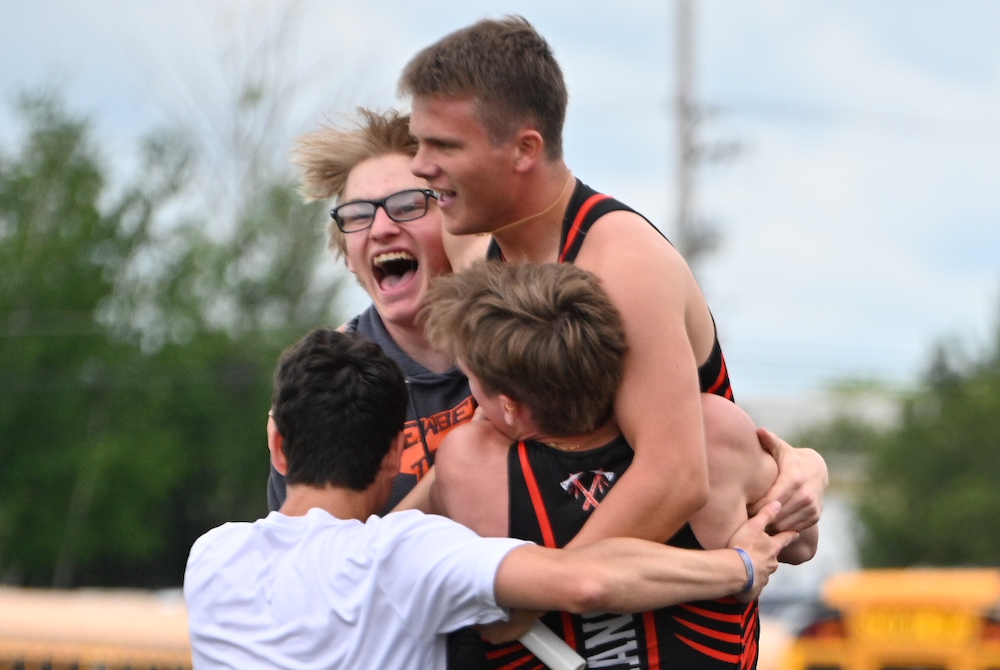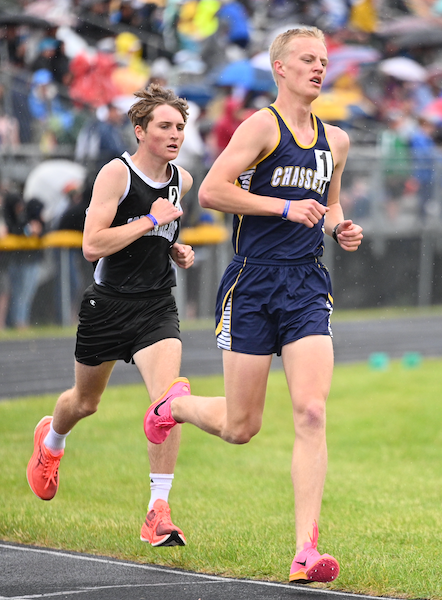
New Math: Division & Multiplication Problems
July 25, 2017
By Jack Roberts
MHSAA Executive Director
This is the second part in a series on MHSAA tournament classification, past and present, that will be published over the next two weeks. This series originally ran in this spring's edition of MHSAA benchmarks.
High school tournament classifications went viral before there was social media and most of us knew what “viral” meant.
Much as a virus infects computers today or has created epidemics of disease around the world for centuries, high school tournament classification – once introduced – tends to spread uncontrollably. Once started, it tends to keep expanding and rarely contracts.
While we are still some distance from providing every team a trophy as a result of expanding high school tournament classification across the country, there is criticism nevertheless that we are headed in that direction – a philosophy which is supposed to exist only in local youth sports for our youngest children.
Michigan could be blamed for all this. Michigan is generally accepted as the first state to provide different classifications for season-ending tournaments for different sized schools. It started a century ago. Today, every state has various classifications for its tournaments in most if not all sports. And it is a bit ironic that Michigan – creator of the classification chaos – more than most other states has kept the number of tournament classes or divisions under control.
Yes, there is evidence that tournament classifications have expanded over the years in Michigan, especially with the relatively recent introduction of tournaments in football and the late 1990s’ move from classes to divisions in most MHSAA tournaments. But the MHSAA Representative Council has held true to its word when it expanded the playoffs for football from four classes to eight divisions: this is needed because of unique factors of football, factors that exist in no other sport; and all other sports should be capped at a maximum of four classes or divisions.
Kentucky is the preeminent defender of single-class basketball. All of its 276 high schools compete for the single state championship for each gender. In Indiana, there are still open wounds from its move in 1998 from one to four classes for its 400 schools in basketball.
Multi-class tournaments have tended to increase the number of non-public school champions, which some states are trying to lower through enrollment “multipliers,” and also tend to increase the number of repeat champions, which some states are trying to affect with “success factors” which lift smaller schools into classifications for larger schools if they take home too many trophies.
While there is considerable evidence that state tournaments do as much bad as good for educational athletics, state associations persist in providing postseason tournaments because, on balance, the experiences are supposed to be good for student-athletes. And once we reach that conclusion it is just a small leap to believe that if the tournaments are good for a few, they must be better for more – which leads to creating more and more tournament classifications. One becomes two classes, then three, then four and so forth.
While the argument is that more classifications or divisions provides more students with opportunities to compete and win, it is undeniable that the experience changes as the number of tournament classifications expands. It is not possible for state associations to provide the same level of support when tournament classifications expand to multiple venues playing simultaneously. For example, there is less audio and video broadcast potential at each venue, and less media coverage to each venue. Focus is diluted and fans diminished at each championship.
No one can argue reasonably that today's two-day MHSAA Football Finals of eight championship games has the same pizazz as the one-day, four-games event conducted prior to 1990.
In some states the number of divisions has grown so much that it is difficult to see much difference between the many season-ending state championship games and a regular-season event in the same sport.
It is a balancing act. And Michigan has been studying that balance longer than any other state, and charting a steadier course than most.
Addition by Division
The shift to Divisions for MHSAA Tournament play in numerous sports has added up to a greater number of champions for teams and individuals across the state. Following are the sports currently employing a divisional format, and the procedures for determining enrollment and classification.
In 23 statewide or Lower Peninsula tournaments, schools which sponsor the sport are currently divided into nearly equal divisions. They are:
- Baseball - 4 Divisions
- Boys Bowling - 4 Divisions
- Girls Bowling - 4 Divisions
- Girls Competitive Cheer - 4 Divisions
- LP Boys Cross Country - 4 Divisions
- LP Girls Cross Country - 4 Divisions
- LP Boys Golf - 4 Divisions
- LP Girls Golf - 4 Divisions
- Ice Hockey - 3 Divisions
- Boys Lacrosse - 2 Divisions
- Girls Lacrosse - 2 Divisions
- Boys Skiing - 2 Divisions
- Girls Skiing - 2 Divisions
- LP Boys Soccer - 4 Divisions LP
- Girls Soccer - 4 Divisions
- Girls Softball - 4 Divisions
- LP Boys Swimming & Diving - 3 Divisions
- LP Girls Swimming & Diving - 3 Divisions
- LP Boys Tennis - 4 Divisions
- LP Girls Tennis - 4 Divisions
- LP Boys Track & Field - 4 Divisions
- LP Girls Track & Field - 4 Divisions
- Wrestling - 4 Divisions
Lists of schools for each division of these 23 tournaments are posted on MHSAA.com approximately April 1. Listings of schools in Upper Peninsula tournaments for their sports are also posted on MHSAA.com. The lists are based on school memberships and sports sponsorships in effect or anticipated for the following school year, as known to the MHSAA office as of a date in early March.
In football, the 256 schools which qualify for MHSAA 11-player playoffs are placed in eight equal divisions annually on Selection Sunday. Beginning in 2017, the 8-player divisions will be determined in a like manner on Selection Sunday as well, with 32 qualifying schools placed in two divisions.
Schools have the option to play in any higher division in one or more sports for a minimum of two years.
The deadlines for "opt-ups" are as follows:
- Applications for fall sports must be submitted by April 15
- Applications for winter sports must be submitted by Aug. 15
- Applications for spring sports must be submitted by Oct. 15
Subsequent to the date of these postings for these tournaments, no school will have its division raised or lowered by schools opening or closing, schools adding or dropping sports, schools exercising the option to play in a higher division, or approval or dissolution of cooperative programs.
When the same sport is conducted for boys and girls in the same season (e.g., track & field and cross country), the gender that has the most sponsoring schools controls the division breaks for both genders.

With 2nd Place in Final Race, Newberry Clinches 1st in Final Team Standings
By
John Vrancic
Special for MHSAA.com
June 2, 2024
KINGSFORD — The race for the Upper Peninsula Division 3 boys track & field championship came right down to the wire Saturday as Newberry edged St. Ignace 96-92 for top honors.
Third-place team finisher Lake Linden-Hubbell won the day’s final race, the 1,600-meter relay, in 3 minutes, 41.94 seconds, and Newberry hung on to edge St. Ignace by two steps for second place and its first title in eight years.
Newberry, which was runner-up to Munising last year, was clocked at 3:43.07 in the 1,600 relay on this sunny and mild late afternoon. The Saints finished nine hundredths of a second later.
“We knew we had to beat St. Ignace to win,” Newberry senior Kennedy Depew said after finishing the anchor leg. “This was my last race ever. I knew I had to give it my all. That’s also why I knew I had to scratch from the open 400. I would have been in four events. I think scratching from the 400 helped me save some energy. We weren’t satisfied with runner-up last year, which makes this year’s championship all the more satisfying.”
Classmate Gabe Luck provided Newberry with its lone individual first with a heave of 44 feet, 1¾ inches in shot put.
“We had a lot of injuries this year,” Newberry coach Drew Schultz said. “For all the obstacles we had, we wouldn’t have it any other way, having two of the best athletes decide it in the last race. I’m extremely proud of our guys. To win it that way is just insane. I’m proud of all our eastern-end kids.”
 Depew also was runner-up in the 100-meter dash in 11.63 seconds.
Depew also was runner-up in the 100-meter dash in 11.63 seconds.
Senior Jon Ingalls, who ran the last leg for the Saints, won the 110 hurdles (16.39) and 300s (42.89) and helped them place second in the 400 relay (45.94).
“Both hurdles were decent,” Ingalls said. “Those weren’t my best times, but it feels good to grind out a few more wins.”
Senior Owen Lester also provided the Saints with a victory in pole vault (12-6).
LL-H got firsts from senior Gabe Popko in discus at 153 feet, 4¼ inches, and classmate Matt Jokela in the 400 (51.09). Jokela also took third in the 100 (11.65).
“Real good hydration and confidence are keys,” Jokela said. “I think having confidence helps a little. I usually don’t go too hard out of the blocks. Then, I usually try to go as hard as I can in the last 200.”
Chassell junior Kalvin Kytta claimed three firsts, taking the 800 in a personal-best 2:03.62, 1,600 (4:39.58) and 3,200 (10:27.32).
“Three wins, I’m pretty happy with that,” he said. “The 800 went real well. Overall, I’m very happy with my performance today.”
Fourth-place Bessemer set UPD3 Finals records in the 400 relay (45.3) and 800 (1:34.64). Powers North Central previously set the record in the 400 (45.34) two years ago and Rock Mid Peninsula had held the 800 record since 2001 when it ran a 1:35.1.
“We shaved two seconds off in the 800 relay which feels good, and our handoffs in the 400 were good all year,” Bessemer senior Landon Peterson said. “Our school record in the 400 is 44.98, which is something we’ve done three times this year. Running on a rubber track gives you a much better grip, which helped us a lot today.”
Bessemer senior Tom Trudgeon became a four-event winner, also taking the 100 (11.46) and 200 (23.85).
Crystal Falls Forest Park freshman Vic Guiliani won high jump (6-0), and sophomore Michael Rexford went 19-9 in long jump, providing Escanaba Holy Name with its first U.P. Finals title since the school reopened in 2021.
PHOTOS (Top) Newberry runners celebrate taking second place in the 1,600 relay, allowing them to finish ahead of St. Ignace for the team title in Upper Peninsula Division 3. (Middle) Chassell's Kalvin Kytta and Cedarville/DeTour's Ethan Snyder lead the pack of 1,600 runners. (Click for more from Cara Kamps/RunMichigan.com.)

